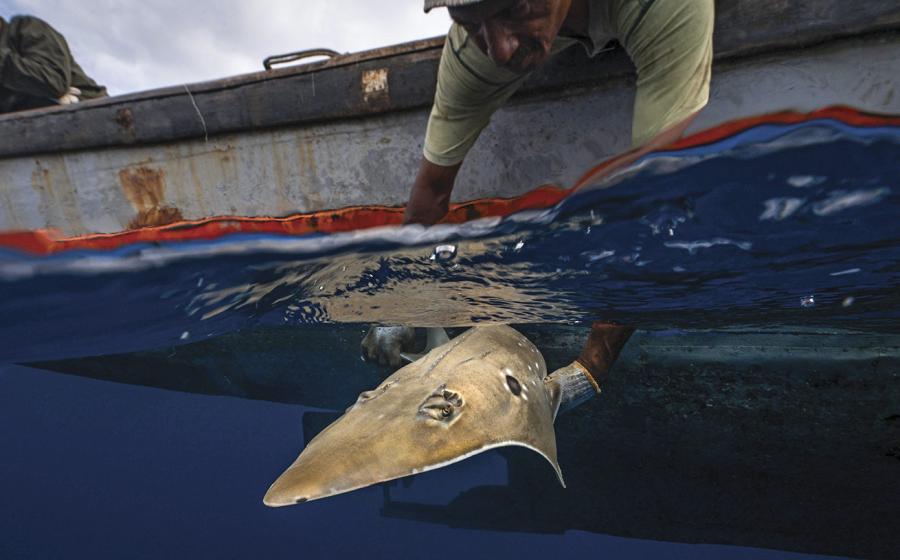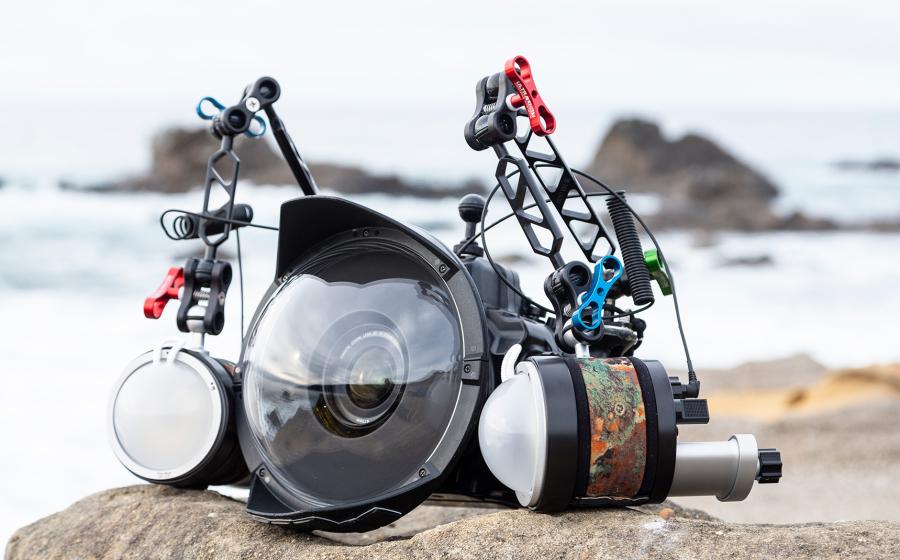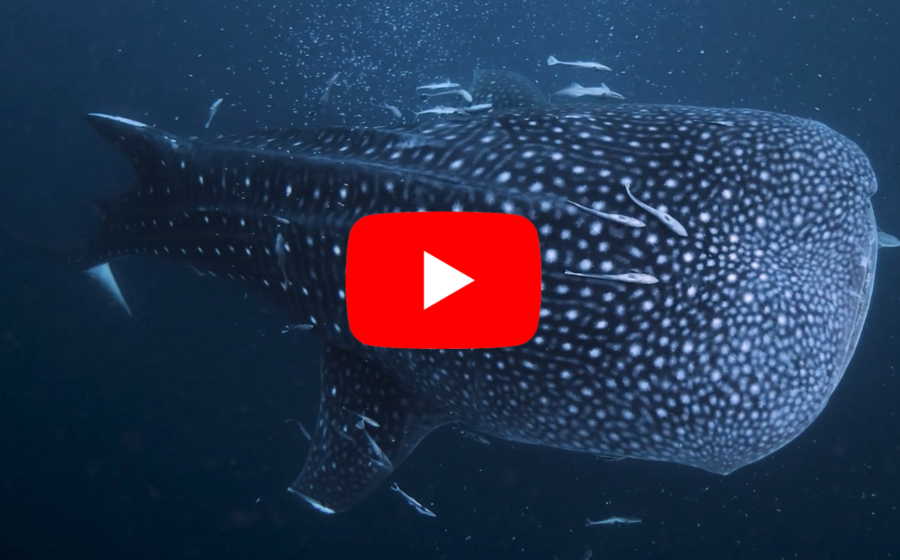Strobe Use in the Digital Era
 |
| TTL works best for photos like this, where the subject occupies a high percentage of the frame. |
December 2003
Text and Photography by Stephen Frink
||
|---|
|  |
|
One of the first lessons underwater photographers learn is that we need artificial light to restore the colors that are lost at depth. Without a strobe, colors are a muted and monochromatic blue-gray at depths greater than 15 feet, no matter how clear the water, no matter how vibrant the reef.
In the old, old, old days, there was no such thing as automatic flash exposure, and in order to choose the right f-stop for their strobe, photographers had to calculate the distance between the strobe and the subject. A combination of strobe-to-subject distance, strobe power, ISO speed and subject reflectivity determined the f-stop.
In the old, old days, external sensors were used to measure the amount of light that bounced back to the subject, so you could quench the strobe power, if necessary. You typically would match the f-stop on the camera to an f-stop option on the sensor, and, theoretically, you'd get the right light output. But because the sensor did not actually see the same angle of view or specific subject that was seen by the lens, this was crude at best. The next iteration of strobe automation changed all that.
This brings us to the merely old days, the days ruled by the Nikonos V and SB-103 strobe. For the first time, the light from the strobe was reflected back through the lens to a sensor that told the strobe when to quench. The cameras and strobes were now sophisticated enough to read the film's sensitivity to light (ISO) and determine how much light was required by the strobe-to-subject distance and subject reflectivity. Because the sensor was located back by the film plane, it worked quite well for most subjects.
Especially with the more sophisticated electronics of housed SLR cameras and the Nikonos RS, through-the-lens (TTL) technology became extremely reliable for fish and macro shots. It became an indispensable tool for a new generation of shooters. TTL wasn't great for wide-angle, and it often failed when the subject was too small to reflect much light back to the sensor, but in a lot of situations it was a technology that increased the percentage of keepers. No wonder many shooters were disappointed when they discovered the temptress of digital technology required them to spurn their old love, TTL.
||
|---|
|  |
|
| This Sea & Sea DX3000 uses a fiber-optic cord to sync the integrated and external strobes.|
The new reality is that CCD and CMOS sensors do not reflect light the same way that film does, and so the strobes that were calibrated to analog media will not work for digital. There are exceptions, such as the Fuji S2, which is compatible with conventional TTL strobes. Other manufacturers, like Nikon with its D100 and D1X, use D-TTL, which utilizes as many as 15 virtually indiscernible preflashes to gauge exposure prior to the primary flash. Their dedicated topside flashes can handle this task, but none of the submersible strobes presently on the market can.
Not only does a normal TTL strobe not function accurately with digital cameras, but most digital cameras know something is amiss and typically won't trip the shutter at all. This fact forced manufacturers to create either new dedicated digital sync cords or to wire their sync ports or hot shoes differently, depending on whether a manual strobe or D-TTL strobe was to be used.
Clearly, things are now getting a bit complicated. The newest image capture technology forces shooters to accept the oldest manual strobe techniques. There's a very significant twist, however, because with digital you can see the results immediately and make corrections as needed. Here's an overview of the various strobe options for digital cameras today:
Internal Strobe Only
This is the easy point-and-shoot solution used by many of the inexpensive clear plastic and Lexan housings for consumer digital cameras. The camera's built-in strobe, which is essentially TTL, provides the illumination. So long as you're close to the subject and the water is clear, this works fine for digital snapshots. The problem occurs when there is too much particulate matter in the water. Having the flash so close to the lens inevitably creates backscatter. Also, mounting an external optical accessory such as a supplementary wide-angle lens might block the flash.
Internal and External
There are a few solutions that use the camera's internal flash, block it so it can't create backscatter, yet still use it to trigger an external flash. Sea & Sea uses an internal deflector in both its DX3000 housing and AquaPix DX-3100 amphibious camera, which bounces the strobe to a fiber-optic receptacle, which, in turn, fires an external strobe. Pioneer Research uses a similar concept in its ReefMaster cameras. Here, an external deflector bounces light to a dedicated slave strobe, firing the submersible strobe in sync. In both cases, these are manual strobe exposures, but by changing the power setting on the strobe or adjusting the strobe-to-subject distance, considerable control is possible. (Note, however, that not just any strobe can be used like this. Most traditional slave strobes fire when they detect any flash, even a preflash, and most can't recycle in time to fire again when the main flash goes off. A "digital" flash may be required.)
The Ikelite Solutions
||
|---|
|  |
|
| Digital shooters are learning that TTL technology is not required for great underwater photos.|
Ikelite has devoted plenty of creative thought to the issue of how to bring strobe light to digital cameras. The company offers housings for a wide variety of consumer point-and-shoots and digital SLRs, and also manufactures a line of popular submersible strobes. Overcoming digital strobe barriers has become its mission. Ikelite engineer Roger Carlson suggests several different options for digital lighting:
> A digital sync cord that allows Ikelite conventional strobes such as the SubStrobe 200 to be fired manually with Nikon and Canon D-SLRs.
> A manual controller with a DS sensor that provides preflash emulation with Ikelite's DS-125 and DS-50 strobes, thereby ensuring TTL in sync with the camera's onboard flash.
> A manual E-V controller that can be hardwired inline with Ikelite's DS strobes to provide up to 10 separate power settings for systems that require manual exposures.
Ikelite is committed to ongoing research and development. The company has already cracked the Olympus digital TTL code, and is exploring D-TTL (Nikon) and E-TTL (Canon). Someday soon it may be as easy to shoot Ikelite submersible strobes in D-TTL as it was back in the analog days.
Housed Digital Strobes
Currently, the only way to get true TTL for cameras like the Nikon and Canon D-SLRs is to use their dedicated speedlights. Subal, Seacam and possibly others have specific strobe housings to accommodate these smaller topside flash units. While they do provide excellent exposure automation for fish and macro subjects, the beam does not spread nearly enough to cover the wide-angle lens.
Manual External Strobe
Actually, since I began shooting in the old, old, old days, and never really switched over to TTL, shooting 100 percent manual was the natural solution for me. But for others who love TTL, not having it with their digital cameras was at first intimidating. Many find, however, that the immediate image review of digital photography makes shooting manual a snap--just shoot, review, adjust and reshoot.
|| |---|
| |
| TTL works best for photos like this, where the subject occupies a high percentage of the frame.|
|
| TTL works best for photos like this, where the subject occupies a high percentage of the frame.|
December 2003
Text and Photography by Stephen Frink
|| |---|
| |
One of the first lessons underwater photographers learn is that we need artificial light to restore the colors that are lost at depth. Without a strobe, colors are a muted and monochromatic blue-gray at depths greater than 15 feet, no matter how clear the water, no matter how vibrant the reef.
|
One of the first lessons underwater photographers learn is that we need artificial light to restore the colors that are lost at depth. Without a strobe, colors are a muted and monochromatic blue-gray at depths greater than 15 feet, no matter how clear the water, no matter how vibrant the reef.
In the old, old, old days, there was no such thing as automatic flash exposure, and in order to choose the right f-stop for their strobe, photographers had to calculate the distance between the strobe and the subject. A combination of strobe-to-subject distance, strobe power, ISO speed and subject reflectivity determined the f-stop.
In the old, old days, external sensors were used to measure the amount of light that bounced back to the subject, so you could quench the strobe power, if necessary. You typically would match the f-stop on the camera to an f-stop option on the sensor, and, theoretically, you'd get the right light output. But because the sensor did not actually see the same angle of view or specific subject that was seen by the lens, this was crude at best. The next iteration of strobe automation changed all that.
This brings us to the merely old days, the days ruled by the Nikonos V and SB-103 strobe. For the first time, the light from the strobe was reflected back through the lens to a sensor that told the strobe when to quench. The cameras and strobes were now sophisticated enough to read the film's sensitivity to light (ISO) and determine how much light was required by the strobe-to-subject distance and subject reflectivity. Because the sensor was located back by the film plane, it worked quite well for most subjects.
Especially with the more sophisticated electronics of housed SLR cameras and the Nikonos RS, through-the-lens (TTL) technology became extremely reliable for fish and macro shots. It became an indispensable tool for a new generation of shooters. TTL wasn't great for wide-angle, and it often failed when the subject was too small to reflect much light back to the sensor, but in a lot of situations it was a technology that increased the percentage of keepers. No wonder many shooters were disappointed when they discovered the temptress of digital technology required them to spurn their old love, TTL.
|| |---|
| |
| This Sea & Sea DX3000 uses a fiber-optic cord to sync the integrated and external strobes.|
The new reality is that CCD and CMOS sensors do not reflect light the same way that film does, and so the strobes that were calibrated to analog media will not work for digital. There are exceptions, such as the Fuji S2, which is compatible with conventional TTL strobes. Other manufacturers, like Nikon with its D100 and D1X, use D-TTL, which utilizes as many as 15 virtually indiscernible preflashes to gauge exposure prior to the primary flash. Their dedicated topside flashes can handle this task, but none of the submersible strobes presently on the market can.
|
| This Sea & Sea DX3000 uses a fiber-optic cord to sync the integrated and external strobes.|
The new reality is that CCD and CMOS sensors do not reflect light the same way that film does, and so the strobes that were calibrated to analog media will not work for digital. There are exceptions, such as the Fuji S2, which is compatible with conventional TTL strobes. Other manufacturers, like Nikon with its D100 and D1X, use D-TTL, which utilizes as many as 15 virtually indiscernible preflashes to gauge exposure prior to the primary flash. Their dedicated topside flashes can handle this task, but none of the submersible strobes presently on the market can.
Not only does a normal TTL strobe not function accurately with digital cameras, but most digital cameras know something is amiss and typically won't trip the shutter at all. This fact forced manufacturers to create either new dedicated digital sync cords or to wire their sync ports or hot shoes differently, depending on whether a manual strobe or D-TTL strobe was to be used.
Clearly, things are now getting a bit complicated. The newest image capture technology forces shooters to accept the oldest manual strobe techniques. There's a very significant twist, however, because with digital you can see the results immediately and make corrections as needed. Here's an overview of the various strobe options for digital cameras today:
Internal Strobe Only
This is the easy point-and-shoot solution used by many of the inexpensive clear plastic and Lexan housings for consumer digital cameras. The camera's built-in strobe, which is essentially TTL, provides the illumination. So long as you're close to the subject and the water is clear, this works fine for digital snapshots. The problem occurs when there is too much particulate matter in the water. Having the flash so close to the lens inevitably creates backscatter. Also, mounting an external optical accessory such as a supplementary wide-angle lens might block the flash.
Internal and External
There are a few solutions that use the camera's internal flash, block it so it can't create backscatter, yet still use it to trigger an external flash. Sea & Sea uses an internal deflector in both its DX3000 housing and AquaPix DX-3100 amphibious camera, which bounces the strobe to a fiber-optic receptacle, which, in turn, fires an external strobe. Pioneer Research uses a similar concept in its ReefMaster cameras. Here, an external deflector bounces light to a dedicated slave strobe, firing the submersible strobe in sync. In both cases, these are manual strobe exposures, but by changing the power setting on the strobe or adjusting the strobe-to-subject distance, considerable control is possible. (Note, however, that not just any strobe can be used like this. Most traditional slave strobes fire when they detect any flash, even a preflash, and most can't recycle in time to fire again when the main flash goes off. A "digital" flash may be required.)
The Ikelite Solutions
|| |---|
| |
| Digital shooters are learning that TTL technology is not required for great underwater photos.|
Ikelite has devoted plenty of creative thought to the issue of how to bring strobe light to digital cameras. The company offers housings for a wide variety of consumer point-and-shoots and digital SLRs, and also manufactures a line of popular submersible strobes. Overcoming digital strobe barriers has become its mission. Ikelite engineer Roger Carlson suggests several different options for digital lighting:
|
| Digital shooters are learning that TTL technology is not required for great underwater photos.|
Ikelite has devoted plenty of creative thought to the issue of how to bring strobe light to digital cameras. The company offers housings for a wide variety of consumer point-and-shoots and digital SLRs, and also manufactures a line of popular submersible strobes. Overcoming digital strobe barriers has become its mission. Ikelite engineer Roger Carlson suggests several different options for digital lighting:
> A digital sync cord that allows Ikelite conventional strobes such as the SubStrobe 200 to be fired manually with Nikon and Canon D-SLRs.
> A manual controller with a DS sensor that provides preflash emulation with Ikelite's DS-125 and DS-50 strobes, thereby ensuring TTL in sync with the camera's onboard flash.
> A manual E-V controller that can be hardwired inline with Ikelite's DS strobes to provide up to 10 separate power settings for systems that require manual exposures.
Ikelite is committed to ongoing research and development. The company has already cracked the Olympus digital TTL code, and is exploring D-TTL (Nikon) and E-TTL (Canon). Someday soon it may be as easy to shoot Ikelite submersible strobes in D-TTL as it was back in the analog days.
Housed Digital Strobes
Currently, the only way to get true TTL for cameras like the Nikon and Canon D-SLRs is to use their dedicated speedlights. Subal, Seacam and possibly others have specific strobe housings to accommodate these smaller topside flash units. While they do provide excellent exposure automation for fish and macro subjects, the beam does not spread nearly enough to cover the wide-angle lens.
Manual External Strobe
Actually, since I began shooting in the old, old, old days, and never really switched over to TTL, shooting 100 percent manual was the natural solution for me. But for others who love TTL, not having it with their digital cameras was at first intimidating. Many find, however, that the immediate image review of digital photography makes shooting manual a snap--just shoot, review, adjust and reshoot.






